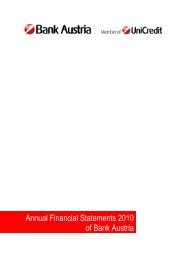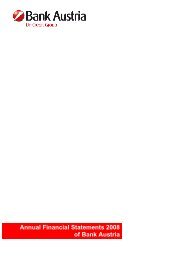Annual Financial Statements 2011 of Bank Austria
Annual Financial Statements 2011 of Bank Austria
Annual Financial Statements 2011 of Bank Austria
You also want an ePaper? Increase the reach of your titles
YUMPU automatically turns print PDFs into web optimized ePapers that Google loves.
Consolidated <strong>Financial</strong> <strong>Statements</strong> in accordance with IFRSs<br />
In <strong>2011</strong>, the new CRD III rules for the trading book were implemented in <strong>Bank</strong> <strong>Austria</strong> in cooperation with UniCredit. This included, in particular,<br />
the implementation <strong>of</strong> “stressed VaR” and “incremental risk charge” (IRC) in the <strong>Bank</strong> <strong>Austria</strong> Group. The college <strong>of</strong> supervisors (Italy, Germany<br />
and <strong>Austria</strong>) gave its regulatory approval in December <strong>2011</strong>. The values for “stressed VaR” and “IRC” are included in regulatory reporting as at<br />
the end <strong>of</strong> <strong>2011</strong>.<br />
A product introduction process has been established for the introduction <strong>of</strong> new products in the area <strong>of</strong> market risk in which risk managers play<br />
a decisive role in approving products. When the new model was approved by the college <strong>of</strong> supervisors (Italy, Germany and <strong>Austria</strong>) in April <strong>2011</strong>,<br />
a multiplier <strong>of</strong> 3.5 was set and this is used for calculating the capital requirement.The new model is used for UniCredit <strong>Bank</strong> <strong>Austria</strong> AG, as until<br />
now, and for the <strong>Bank</strong> <strong>Austria</strong> Group. The risk model covers all major risk categories: interest rate risk and equity risk (both general and specific),<br />
currency risk and commodity position risk. The structure <strong>of</strong> the standard risk report presented at MACO’s weekly meetings covers (stress) sensitivities<br />
in addition to VaR figures, and utilisation levels in the areas <strong>of</strong> IRC and S-VaR (both for the regulatory trading books). Regular and specific<br />
stress scenario calculations complement the information provided to MACO/ALCO and the Management Board. Macro scenarios show the potential<br />
adverse impacts <strong>of</strong> global developments with specific effects on the respective risk categories, while stress sensitivities <strong>of</strong> individual risk<br />
factors or groups <strong>of</strong> risk factors show the potential adverse impacts on partial market segments. Stress scenarios are based on assumptions <strong>of</strong><br />
extreme movements in individual market risk parameters. The bank analyses the effect <strong>of</strong> such fluctuations and a liquidity disruption in specific<br />
products and risk factors on the bank’s results. These assumptions <strong>of</strong> extreme movements are dependent on currency, region, liquidity and the<br />
credit rating, and are set by Market Risk on a discretionary basis after consultation with experts in other areas <strong>of</strong> the bank (e.g. research, trading,<br />
Market Risk UniCredit holding company). The Widespread Contagion Scenario is an example <strong>of</strong> a scenario which is also used by the UniCredit<br />
holding company on a Group-wide basis.<br />
In addition to the risk model results, income data from market risk activities are also determined and communicated on a daily basis. These data<br />
are presented over time and compared with current budget figures. Reporting covers the components reflected in IFRS-based pr<strong>of</strong>it and the<br />
marking to market <strong>of</strong> all investment positions regardless <strong>of</strong> their recognition in the IFRS-based financial statements (“total return”). The results<br />
are available to UniCredit <strong>Bank</strong> <strong>Austria</strong>’s trading and risk management units via the access-protected Intranet application “ERCONIS”, broken<br />
down by portfolio, income statement item and currency. The regulatory approach to prudent valuation in the trading book is implemented<br />
primarily by Market Risk and further developed on an ongoing basis through cooperation within UniCredit Group in the same way as “independent<br />
price verification”, which establishes valuation processes and verification procedures on a harmonised Group-wide basis.<br />
In Vienna, <strong>Bank</strong> <strong>Austria</strong> uses the “MARCONIS” system developed by the bank itself to completely and systematically review the market conformity<br />
<strong>of</strong> its trading transactions. The scope <strong>of</strong> application <strong>of</strong> this tool has been further extended to include all CEE banking subsidiaries with market risk<br />
activities. Since 2010 the MARCONIS system has been extended to include another module, and the tool is also used to address the topic <strong>of</strong><br />
price transparency (determining minimum margins and maximum hedging costs for Corporate Treasury Sales).<br />
The chart below shows the VaR in <strong>2011</strong> calculated on the basis <strong>of</strong> the new market risk model, which has also been used since the end <strong>of</strong> April<br />
<strong>2011</strong> for regulatory reporting <strong>of</strong> capital requirements for market risk.<br />
VaR <strong>of</strong> the <strong>Bank</strong> <strong>Austria</strong> Group in <strong>2011</strong> calculated on the basis <strong>of</strong> the new IMOD market risk model (€ m)<br />
–120<br />
–110<br />
–100<br />
–90<br />
–80<br />
–70<br />
–60<br />
–50<br />
–40<br />
–30<br />
–20<br />
–10 0<br />
IMOD-VaR<br />
Jan. 11 Feb. 11 March 11 April 11 May 11 June 11 July 11 Aug. 11 Sept. 11 Oct. 11 Nov. 11 Dec. 11<br />
IMOD-VaR Trading<br />
IMOD-VaR Limit scope<br />
At the end <strong>of</strong> <strong>2011</strong>, market risk <strong>of</strong> the <strong>Bank</strong> <strong>Austria</strong> Group (top line) was about € 90 m (confidence interval <strong>of</strong> 99%; 1-day holding period).<br />
The decline in the first quarter <strong>of</strong> <strong>2011</strong> was mainly due to the fact that the time window (500 days) for historical simulations no longer included<br />
extreme scenarios. The renewed increase in the third quarter <strong>of</strong> <strong>2011</strong> was caused by increasing credit spread volatility (triggered by the mounting<br />
<strong>Bank</strong> <strong>Austria</strong> · <strong>Annual</strong> <strong>Financial</strong> <strong>Statements</strong> <strong>2011</strong><br />
139
















